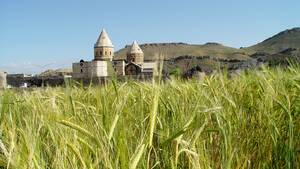
Armenian Monastic Ensembles of Iran, Across Aras
East Azerbaijan & West AzerbaijanJolfa
Jolfa is located in the northwestern of the province, at the height of 710 meters above the sea...Maku
Maku is located in the north east of west Azarbaijan and enjoys a specific geographical and natural location. Maku...
Chalderan
Chalderan county is located in the northwest of West Azarbaijan province and has various names such as Qare...
In the list of World Heritage Sites, there are three Iranian churches, known as Armenian Monastic Ensembles of Iran or Azerbaijan churches. All of these churches are located in northwestern Iran. We recommend you to visit them on this itinerary. The first and the most famous is Saint Stepanos Monastery, located in Jolfa. Jolfa also has a train station, to access Jolfa by train, it’s better to go to Tabriz train station and take the ticket of Tabriz-Jolfa local train. Tabriz-Jolfa is an electric train and environmental friendly. Jolfa is located near the border of Iran and Nakhjavan.
From Jolfa you ought to proceed the border road across Aras River, while you exit Jolfa, Safavid Khajehnazar Caravanserai emerges in front of you immediately. Caravanserai has been restored recently and it’s possible to visit. There is one of the tiniest Armenian shrines beside the road which is called Shepherd Monastery.
Saint Stepanos Monastery is located 15 kilometers far from Jolfa. There is a parking lot there which is linked to the main road by an asphalted route. There is a route to walk to access monastery, it’s about 15 minutes slightly uphill.
After visiting Saint Stepanos Monastery, it’s time to back to the border road across pretty Aras following your journey. There is a lake beside the road but not a natural one, it’s the lake of Aras Dam. The lake of Aras Dam is vast enough to be in landscape till on your arrival to Miladshahr. The border road continues to Poldasht.
The closest city to find a suitable hostel is Maku. You would stay a night in hostels, hotels or rural houses around Maku. Bazargan, the border city, also has many hostels and hotels.
Day 2
The next church is Dzordzor Church near Maku. In order to visit it you ought to depart from Poldasht to Yulagaldi three-way junction, then proceed the western route to Maku, after arriving Maku route to Barun direction. Barun is a tiny village in the south of Maku.
Barun route is a mountainous pretty road with a landscape of stone city Maku, you can even see the Ararat summits from this road. Dzordzor Church is located near the Lake of Barun Dam. The chapel was in the valley during the construction of the dam, but the experts transfer the building into a higher place to prevent drowning.
The third church is Qara Kelisa means Black Church, it’s located near Chaldoran. After visiting Dzordzor you ought to back to Maku and by routing to Shut depart to Chaldiran. There is another direction too which is more beautiful.
In Maku-Bazargan road, exit the main road near Keshmeshtappeh, then enter the road of Avajiq. It’s about 20 kilometers before arriving Maku, there is one of the picturesque natural attractions of Iran, Maku Basalt Columns. These basalt columns would be attractive for geologists. There is a big sign beside the road to inform you and there is no need to be worried about finding this natural attraction.
Avajiq road finally reaches Chaldiran and it’s a good opportunity to visit the tomb of Sayyed Sadr-Al-Din, the loyal general of Shah Ismail Safavi, the general who was killed in Chaldorab Battle. He buried in a place which was the main battlefield. It would be the last place to visit so you can rest in Chaldiran a night.
Day 3
It’s about half an hour from Chaldiran to Qara Kelisa. This Monastery is one of the oldest in the world. It also is known as Tataus or Thaddeus the saint church. Because of the black facing of the first walls of the monastery, it was called Black Church (Qara Kelisa).
To continue your trip, it’s better to proceed to Urmia from Qarazia-Al-Din road across Urmia Lake.